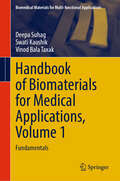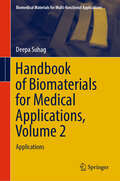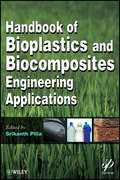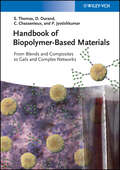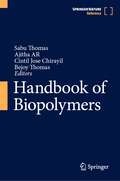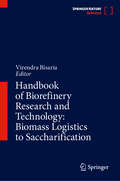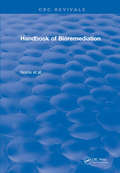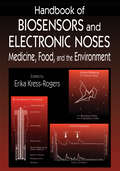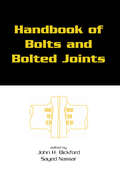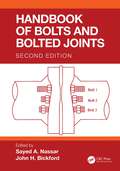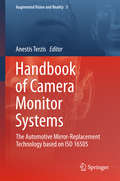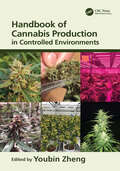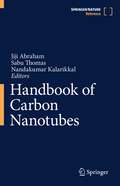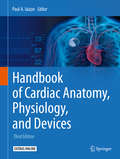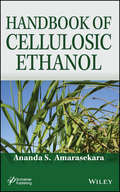- Table View
- List View
Handbook of Bioinspired Algorithms and Applications
by Albert Y. Zomaya Stephan OlariuThe mystique of biologically inspired (or bioinspired) paradigms is their ability to describe and solve complex relationships from intrinsically very simple initial conditions and with little or no knowledge of the search space. Edited by two prominent, well-respected researchers, the Handbook of Bioinspired Algorithms and Applications reveals the
Handbook of Biomass
by Sabu Thomas Cintil Jose Chirayil Mahesh Hosur Daniel PasquiniThis handbook constitutes state-of-the-art research covering topics such as chemical constituents of biomass, their specific properties, characterization and different applications. The contents also discuss challenges and issues involved in its applications. This volume brings together a number of biomass-derived potential renewable elements and its circular economy approach in one place. The content includes industrial applications and fills the gap in laboratory research works to practical applications in related industries. The book gives an insight towards the circular economy approach by the biomass, different gross morphologies of biomasses and the valuable chemical constituents that can be derived from the biomass and moreover the potential applications of all those constituents. It enables researchers and scientists to get informed of the designs to improve existing utilization of biomass in an efficient manner and deliver better products at lower cost.The volume isuseful reference for professionals, researchers, industrial practitioners, graduate students and senior undergraduates in the fields of polymer science, bioscience and bioengineering. It also provides an in-depth reference for biomass processors and fabricators and for industry sectors utilizing biomass such as packaging, sensors, film manufacturers, medical device manufacturers and biomedical engineers.
Handbook of Biomaterial Properties
by Jonathan Black William Murphy Garth HastingsThis book provides tabular and text data relating to normal and diseased tissue materials and materials used in medical devices. Comprehensive and practical for students, researchers, engineers, and practicing physicians who use implants, this book considers the materials aspects of both implantable materials and natural tissues and fluids. Examples of materials and topics covered include titanium, elastomers, degradable biomaterials, composites, scaffold materials for tissue engineering, dental implants, sterilization effects on material properties, metallic alloys, and much more. Each chapter author considers the intrinsic and interactive properties of biomaterials, as well as their appropriate applications and historical contexts. Now in an updated second edition, this book also contains two new chapters on the cornea and on vocal folds, as well as updated insights, data, and citations for several chapters.
Handbook of Biomaterials for Medical Applications, Volume 1: Fundamentals (Biomedical Materials for Multi-functional Applications)
by Deepa Suhag Swati Kaushik Vinod Bala Taxak"Handbook on Biomaterials for Medical Applications: Fundamentals" is a critical monograph that merges advanced technological insights with practical applications in biomedical materials science. It navigates through the intricate blend of theoretical knowledge and real-world medical practices, highlighting the significant roles these materials play in enhancing therapeutic outcomes. Addressing the interdisciplinary nature of the field, the book incorporates perspectives from chemistry, biology, engineering, and clinical medicine. This comprehensive guide covers novel biomaterials, advanced drug delivery systems, innovative tissue engineering, and the emerging field of theranostics, providing a holistic view of how these elements drive medical advancements. This book can be a valuable reference for scholars, researchers, and healthcare practitioners. Its text is richly illustrated with diagrams and tables, facilitating both the understanding and application of complex concepts. With an educational narrative accessible to both experts and beginners, the monograph encourages a passion for innovation and a deep understanding of the transformative potential of multifunctional biomedical materials. It invites readers to explore the confluence of materials science and therapeutic innovation, setting the stage for future breakthroughs in medical science and therapy. It can also be prescribed as a textbook for various graduate and undergraduate courses like tissue engineering and regenerative medicine, nanomedicine, biomedical engineering and biomaterials science and engineering.
Handbook of Biomaterials for Medical Applications, Volume 2: Applications (Biomedical Materials for Multi-functional Applications)
by Deepa Suhag“Handbook on Biomaterials for Medical Applications: Applications " is a comprehensive exploration of the cutting-edge developments in the field of biomedical materials, with a strong focus on their multifunctional applications in therapeutics. This book delves into the innovative materials and techniques that are revolutionizing the way we approach healthcare, offering readers valuable insights into the latest breakthroughs and their potential impact on medical treatments. Its text is richly illustrated with diagrams and tables, facilitating both the understanding and application of complex concepts. This book can be a valuable reference for scholars, researchers, and healthcare practitioners.
Handbook of Bioplastics and Biocomposites Engineering Applications
by Inamuddin Tariq AltalhiHandbook of Bioplastics and Biocomposites Engineering Applications The 2nd edition of this successful Handbook explores the extensive and growing applications made with bioplastics and biocomposites for the packaging, automotive, biomedical, and construction industries. Bioplastics are materials that are being researched as a possible replacement for petroleum-based traditional plastics to make them more environmentally friendly. They are made from renewable resources and may be naturally recycled through biological processes, conserving natural resources and reducing CO2 emissions. The 30 chapters in the Handbook of Bioplastics and Biocomposites Engineering Applications discuss a wide range of technologies and classifications concerned with bioplastics and biocomposites with their applications in various paradigms including the engineering segment. Chapters cover the biobased materials; recycling of bioplastics; biocomposites modeling; various biomedical and engineering-based applications including optical devices, smart materials, cosmetics, drug delivery, clinical, electrochemical, industrial, flame retardant, sports, packaging, disposables, and biomass. The different approaches to sustainability are also treated. Audience The Handbook will be of central interest to engineers, scientists, and researchers who are working in the fields of bioplastics, biocomposites, biomaterials for biomedical engineering, biochemistry, and materials science. The book will also be of great importance to engineers in many industries including automotive, biomedical, construction, and food packaging.
Handbook of Bioplastics and Biocomposites Engineering Applications (Wiley-Scrivener #81)
by Srikanth PillaIn today’s world, bioplastics are becoming increasingly prominent owing mainly to scarcity of oil, increase in the cost of petroleum-based commodities, and growing environmental concerns with the dumping of non-biodegradable plastics in landfills. This book summarizes the field of bioplastics by illustrating how they form a unique class of research area that integrates pure and applied sciences such as chemistry, engineering and materials science, to initate solutions. Compelling science demystics this complex and often ambiguous branch of study for benefit of all those concerned with bioplastics.
Handbook of Biopolymer-Based Materials
by Sabu Thomas P. Jyotishkumar Christophe Chassenieux Dominique DurandThis first systematic scientific reference in the area of micro- and nanostructured biopolymer systems discusses in two volumes the morphology, structure, dynamics, properties and applications of all important biopolymers, as well as their blends, composites, interpenetrating networks and gels.Selected leading researchers from industry, academia, government and private research institutions around the globe comprehensively review recent accomplishments in the field. They examine the current state of the art, new challenges, and opportunities, discussing allthe synthetic routes to the generation of both micro- and nano-morphologies, as well as the synthesis, characterization and application of porous biopolymers.An outstanding resource for anyone involved in the fi eld of eco-friendly biomaterials for advanced technologies.
Handbook of Biopolymers
by Sabu Thomas Ajitha Ar Cintil Jose Chirayil Bejoy ThomasThis book on biopolymers offers a comprehensive source for biomaterial professionals. It covers all elementary topics related to the properties of biopolymers, the production, and processing of biopolymers, applications of biopolymers, examples of biopolymers, and the future of biopolymers. Edited by experts in the field, the book highlights international professionals’ longstanding experiences and addresses the requirements of practitioners and newcomers in this field in finding a solution to their problems. The book brings together several natural polymers, their extraction/production, and physio-chemical features. The topics covered in this book are biopolymers from renewable sources, marine prokaryotes, soy protein and humus oils, biopolymer recycling, chemical modifications, and specific properties. The book also focuses on the potential and diverse applications of biogenic and bio-derived polymers. The content includes industrial applications of natural polymeric molecules and applications in key areas such as material, biomedical, sensing, packaging, biomedicine, and biotechnology, and tissue engineering applications are discussed in detail. The objective of this book is to fill the gap between the researchers working in the laboratory to cutting-edge technological applications in related industries. This book will be a very valuable reference material for graduates and post-graduate students, academic researchers, professionals, research scholars, and scientists, and for anyone who has a flavor for doing biomaterial research. The books are designed to serve as a bridge between undergraduate textbooks in biochemistry and professional literature. The book provides universal perspectives for an emerging field where classical polymer science blends with molecular biology with highlights on recent advances.
Handbook of Biorefinery Research and Technology: Biomass Logistics to Saccharification
by Virendra BisariaThis handbook provides a comprehensive review of the latest scientific developments through authoritative, expertly validated overviews in this field. It covers the basic principles, upfront research accomplishments as well as successful industrial applications. Each chapter is written by a domain expert which besides the in-depth review of the topic also outlines an economic outlook and future directions of research of the area. The book is structured in a way that is appropriate for advanced graduate students and professionals in diverse scientific and engineering communities including biocatalysis, genetic engineering, metabolic engineering, and bioprocess technology.
Handbook of Biorefinery Research and Technology: Production of Biofuels and Biochemicals
by Virendra BisariaThis handbook provides a comprehensive review of the latest scientific developments through authoritative, expertly validated overviews in this field. It covers the basic principles, upfront research accomplishments as well as successful industrial applications. Each chapter is written by a domain expert which besides the in-depth review of the topic also outlines an economic outlook and future directions of research of the area. The book is structured in a way that is appropriate for advanced graduate students and professionals in diverse scientific and engineering communities including biocatalysis, genetic engineering, metabolic engineering, and bioprocess technology.
Handbook of Bioremediation (CRC Press Revivals)
by Robert D. NorrisWritten by leading soil and ground-water remediation scientists, Handbook of Bioremediation presents information regarding the processes, application, and limitations of using remediation technologies to restore contaminated soil and ground water. It covers field-tested technologies, site characterization requirements for each remediation technology, and the costs associated with their implementation. In addition to discussions and examples of developed technologies, the book provides insights into technologies ranging from theoretical concepts to limited field-scale investigations. In situ remediation systems, air sparging and bioventing, the use of electron acceptors other than oxygen, natural bioremediation, and the introduction of organisms into the subsurface are among the specific topics covered in this invaluable handbook.
Handbook of Biosensors and Electronic Noses: Medicine, Food, and the Environment
by Erika Kress-RogersIn developing the electronic nose and biosensor devices, researchers not only copy biochemical pathways, but also use nature's approach to signal interpretation as a blueprint for man-made sensing systems. Commercial biosensors have demonstrated their benefits and practical applications, providing high sensitivity and selectivity, combined with a significant reduction in sample preparation assay time and the use of expensive reagents. The Handbook of Biosensors and Electronic Noses discusses design and optimization for the multitude of practical uses of these devices including:
Handbook of Bolts and Bolted Joints
by John H. Bickford Sayed NassarPresenting time-tested standard as well as reliable emerging knowledge on threaded fasteners and joints, this book covers how to select parts and materials, predict behavior, control assembly processes, and solve on-the-job problems. It examines key issues affecting bolting in the automotive, pressure vessel, petrochemical, aerospace, and structura
Handbook of Bolts and Bolted Joints
by John H. Bickford Sayed A. NassarPresenting time‑tested standards as well as validated emerging knowledge on threaded fasteners and bolted joints, this updated edition covers how to design, select parts and materials, control assembly processes, predict behavior, and solve on‑the‑job problems.This handbook examines key issues affecting bolting in the automotive, pressure vessel, petrochemical, aerospace, energy, and structural steel industries. The editors have successfully created a useful rather than scholarly handbook with chapters written in a straightforward, how‑to manner. Theory is discussed only when necessary and the handbook’s logical organization and thorough index enhance its usefulness. Handbook of Bolts and Bolted Joints, Second Edition includes updated chapters, solved numerical examples, and case studies.This new edition is an essential handbook for professionals, researchers, and students in all fields in which threaded joints are used, including automotive, aerospace, structural, chemical, and naval and ocean engineering, as well as agricultural equipment, wind turbines, and medical devices.
Handbook of Brewing (Food Science and Technology)
by Graham G. Stewart Inge Russell Anne AnstrutherWith a foreword written by Professor Ludwig Narziss—one of the world’s most notable brewing scientists—the Handbook of Brewing, Third Edition, as it has for two previous editions, provides the essential information for those who are involved or interested in the brewing industry. The book simultaneously introduces the basics—such as the biochemistry and microbiology of brewing processes—and also deals with the necessities associated with a brewery, which are steadily increasing due to legislation, energy priorities, environmental issues, and the pressures to reduce costs. Written by an international team of experts recognized for their contributions to brewing science and technology, it also explains how massive improvements in computer power and automation have modernized the brewhouse, while developments in biotechnology have steadily improved brewing efficiency, beer quality, and shelf life.
Handbook of CO₂ in Power Systems
by Panos M. Pardalos Niko A. Iliadis Mario V. Pereira Steffen Rebennack Qipeng P. ZhengThe Handbook of CO in Power Systems' objective is to include the state-of-the-art developments that occurred in power systems taking CO emission into account. The book includes power systems operation modeling with CO emissions considerations, CO market mechanism modeling, CO regulation policy modeling, carbon price forecasting, and carbon capture modeling. For each of the subjects, at least one article authored by a world specialist on the specific domain is included.
Handbook of Camera Monitor Systems
by Anestis TerzisThis handbook offers a comprehensive overview of Camera Monitor Systems (CMS), ranging from the ISO 16505-based development aspects to practical realization concepts. It offers readers a wide-ranging discussion of the science and technology of CMS as well as the human-interface factors of such systems. In addition, it serves as a single reference source with contributions from leading international CMS professionals and academic researchers. In combination with the latest version of UN Regulation No. 46, the normative framework of ISO 16505 permits CMS to replace mandatory rearview mirrors in series production vehicles. The handbook includes scientific and technical background information to further readers' understanding of both of these regulatory and normative texts. It is a key reference in the field of automotive CMS for system designers, members of standardization and regulation committees, engineers, students and researchers.
Handbook of Cannabis Production in Controlled Environments
by Youbin ZhengFor thousands of years, Cannabis sativa, commonly called cannabis or marijuana, has been used for many different purposes. Due to its enormous medicinal values, increasing numbers of countries and regions have started to legalise the cultivation of this plant. When grown commercially, cannabis is most often produced in controlled environments including greenhouse and indoor growing rooms, to ensure consistent growth and high quality. Even for field production, propagation is frequently conducted in controlled environments. Commercial operations and individual growers who cultivate cannabis for personal consumption, require scientific information on how to cultivate cannabis most effectively and efficiently. To meet these needs, scientists have been conducting research on how to optimize cannabis cultivation both in small and large scales. Handbook of Cannabis Production in Controlled Environments is the result of collaborations between some leading cannabis scientists and highly experienced practitioners. Featuring full-color illustrations and photographs throughout, this book covers a broad range of topics include cannabis biology; science and techniques for breeding and propagation; management and optimization of both aerial and rootzone environments; plant nutrition and nutrient disorder diagnosis; crop training and pest management; harvesting and post-harvest processing. Along with the basic aspects of controlled environment cannabis production, this book summarises developments in these areas that may challenge old beliefs and improve production. Led by Editor, Youbin Zheng, President of the Canadian Society for Horticultural Science/La Société Canadienne de Science Horticole, this book is a practical guide for cultivators, consultants, and researchers; a reference for students; and an information source for individuals who grow cannabis for personal consumption.
Handbook of Carbon Nanotubes
by Sabu Thomas Jiji Abraham Nandakumar KalarikkalThis Handbook covers the fundamentals of carbon nanotubes (CNT), their composites with different polymeric materials (both natural and synthetic) and their potential advanced applications. Three different parts dedicated to each of these aspects are provided, with chapters written by worldwide experts in the field. It provides in-depth information about this material serving as a reference book for a broad range of scientists, industrial practitioners, graduate and undergraduate students, and other professionals in the fields of polymer science and engineering, materials science, surface science, bioengineering and chemical engineering.Part 1 comprises 22 chapters covering early stages of the development of CNT, synthesis techniques, growth mechanism, the physics and chemistry of CNT, various innovative characterization techniques, the need of functionalization and different types of functionalization methods as well as the different properties of CNT. A full chapter is devoted to theory and simulation aspects. Moreover, it pursues a significant amount of work on life cycle analysis of CNT and toxicity aspects.Part 2 covers CNT-based polymer nanocomposites in approximately 23 chapters. It starts with a short introduction about polymer nanocomposites with special emphasis on CNT-based polymer nanocomposites, different manufacturing techniques as well as critical issues concerning CNT-based polymer nanocomposites. The text deeply reviews various classes of polymers like thermoset, elastomer, latex, amorphous thermoplastic, crystalline thermoplastic and polymer fibers used to prepare CNT based polymer composites. It provides detailed awareness about the characterization of polymer composites. The morphological, rheological, mechanical, viscoelastic, thermal, electrical, electromagnetic shielding properties are discussed in detail. A chapter dedicated to the simulation and multiscale modelling of polymer nanocomposites is an additional attraction of this part of the Handbook.Part 3 covers various potential applications of CNT in approximately 27 chapters. It focuses on individual applications of CNT including mechanical applications, energy conversion and storage applications, fuel cells and water splitting, solar cells and photovoltaics, sensing applications, nanofluidics, nanoelectronics and microelectronic devices, nano-optics, nanophotonics and nano-optoelectronics, non-linear optical applications, piezo electric applications, agriculture applications, biomedical applications, thermal materials, environmental remediation applications, anti-microbial and antibacterial properties and other miscellaneous applications and multi-functional applications of CNT based polymer nanocomposites. One chapter is fully focussed on carbon nanotube research developments: published papers and patents. Risks associated with carbon nanotubes and competitive analysis of carbon nanotubes with other carbon allotropes are also addressed in this Handbook.
Handbook of Carbon Sensors: Understanding and Applications (Series in Sensors)
by Jg ManjunathaIn an era dominated by environmental challenges and technological advancements, the need for precise and efficient monitoring tools has become paramount. Among these tools, carbon sensors stand as vanguards, revolutionizing our approach to sensing and detection. "Handbook of Carbon Sensors: Understanding and Applications" provides readers with a comprehensive and accessible guide to the world of carbon sensing. The book begins by exploring the basics of carbon sensing, detailing the underlying principles and their foundations before detailing their applications on real-world challenges, including monitoring air quality in urban environments, fine-tuning manufacturing processes in industries, or revolutionizing medical diagnostics. As the book develops, it moves from theoretical foundations to the impact of carbon sensors on our daily lives: from optimizing production lines to ensuring the purity of the air we breathe. It is a valuable reference for graduate students and researchers in environmental science, materials science, and engineering, in addition to scientists working in industry.Key features:- Provides practical insights by incorporating real-world case studies that demonstrate how carbon sensors are actively solving challenges in industries, environmental monitoring, and healthcare.- Caters to a wide range of readers, including students, researchers, and professionals.- Offers a forward-looking perspective on carbon sensing technology, with a dedicated section explores emerging technologies and future trends.
Handbook of Cardiac Anatomy, Physiology, and Devices
by Paul A. IaizzoWith the medical device industry growing at an incredible pace, and the overall understanding of the molecular basis for disease on the rise, today's bio-medical engineers face a constant challenge to re-tool or reinvent devices that remain in step with medical science. In Handbook of Cardiac Anatomy, Physiology, and Devices, Second Edition, leading experts from the University of Minnesota's renowned Lillehei Heart Institute and scientists from Medtronic, Inc. have thoroughly updated and expanded upon the critically acclaimed first edition with the latest information on the anatomic features, underlying physiologic mechanisms, and treatments for diseases of the heart. Key chapters address animal models for cardiac research, cardiac mapping systems, heart-valve disease, and genomics-based tools and technology. Once again, companion compact disks offer unique insights into the working heart, providing color images and movies that enhance the understanding of key points within the text. Comprehensive and state-of-the art, the Handbook of Cardiac Anatomy, Physiology, and Devices, Second Edition provides clinicians and biomedical engineers alike with the authoritative information and background they need to work on and implement tomorrow's generation of life-saving cardiac devices.
Handbook of Cardiac Anatomy, Physiology, and Devices
by Paul A. IaizzoThis book covers the latest information on the anatomic features, underlying physiologic mechanisms, and treatments for diseases of the heart. Key chapters address preclinical animal models for cardiac research and clinical trials performed, cardiac mapping systems, heart-valve therapies and other device-based tools and technologies for cardiac diagnoses and treatments. Once again, companion of supplementary videos offer unique insights into the device-tissue interfaces, including those within beating hearts: i.e., these supplemental videos enhance ones understandings of key points within the text. The “Handbook of Cardiac Anatomy, Physiology and Devices”, the Fourth Edition is a comprehensive and state-of-the art resource textbook that should provide clinicians and biomedical engineers alike, with the authoritative information and background they need to work on and implement tomorrow’s generation of life-saving cardiac therapies and devices.
Handbook of Cell Biosensors
by Sylvia Daunert Shimshon Belkin Sylvain Martel Paul Freemont Julie Hermans Isao Karube Elisa Michelini Aldo RodaThis handbook is an interdisciplinary and comprehensive reference covering all aspects of cell biosensors. It is divided into four main sections which are led and organized by numerous international experts. The scope of coverage includes: Fundamentals and genetics for biosensor applicationsTransducers, Materials and SystemsMarkets, innovation and educationApplication of biosensors in business Biosensor research is an exciting hybrid world where biologists, chemists, physicists, engineers and computer engineers come together. This handbook will serve as an invaluable living resource for all researchers in academia and industry working with cell biosensors.
Handbook of Cellulosic Ethanol
by Ananda S. AmarasekaraComprehensive coverage on the growing science and technology of producing ethanol from the world's abundant cellulosic biomass The inevitable decline in petroleum reserves and its impact on gasoline prices, combined with climate change concerns, have contributed to current interest in renewable fuels. Bioethanol is the most successful renewable transport fuel—with corn and sugarcane ethanol currently in wide use as blend-in fuels in the United States, Brazil, and a few other countries. However, there are a number of major drawbacks in these first-generation biofuels, such as their effect on food prices, net energy balance, and poor greenhouse gas mitigation. Alternatively, cellulosic ethanol can be produced from abundant lignocellulosic biomass forms such as agricultural or municipal wastes, forest residues, fast growing trees, or grasses grown in marginal lands, and should be producible in substantial amounts to meet growing global energy demand. The Handbook of Cellulosic Ethanol covers all aspects of this new and vital alternative fuel source, providing readers with the background, scientific theory, and recent research progress in producing cellulosic ethanol via different biochemical routes, as well as future directions. The seventeen chapters include information on: Advantages of cellulosic ethanol over first-generation ethanol as a transportation fuel Various biomass feedstocks that can be used to make cellulosic ethanol Details of the aqueous phase or cellulolysis route, pretreatment, enzyme or acid saccharification, fermentation, simultaneous saccharification fermentation, consolidated bioprocessing, genetically modified microorganisms, and yeasts Details of the syngas fermentation or thermochemical route, gasifiers, syngas cleaning, microorganisms for syngas fermentation, and chemical catalysts for syngas-to-ethanol conversion Distillation and dehydration to fuel-grade ethanol Techno-economical aspects and the future of cellulosic ethanol Readership Chemical engineers, chemists, and technicians working on renewable energy and fuels in industry, research institutions, and universities. The Handbook can also be used by students interested in biofuels and renewable energy issues.



